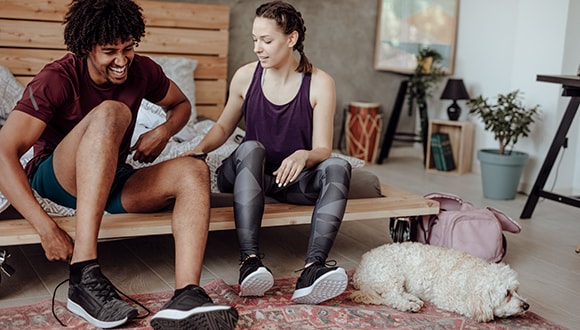When can I return to exercise after COVID?
Knowing when you’re ready to return to exercise after COVID can be different for everyone. These tips will help you restart your regular workout routine safely.
Whether you spent a week on the couch with a relatively mild illness or suffered through more severe symptoms, returning to exercise after recovering from COVID-19 can be challenging.
Your body has used up a lot of energy fighting the infection and it’s normal for fatigue to linger. All that time at home may have affected your muscle strength and general fitness, so you may not be able to jump straight back into your usual level of activity.
Here’s how to return to exercise after COVID and when to stop and get help if you’re concerned about your progress.

Restarting exercise after COVID
If you had mild symptoms, experts recommend waiting until you’ve had at least seven days with no symptoms, or 10 days of rest since symptoms started, before returning to exercise.
Start with low-intensity activities like walking, yoga and gentle body weight exercises. “Take it fairly gently to begin with and try something that takes around half of the effort of what you would normally do and see how you go,” says GP Dr Karen Price, president of the Royal Australian College of General Practitioners (RACGP).
If you have a health condition, Dr Price recommends talking to your doctor or physio before you get moving. But she says most people can eventually return to their previous fitness level.
It can be frustrating if you’ve lost some of your fitness, but Dr Price says it’s helpful to focus on what you can do rather than what you’re not yet able to do. “After a potentially major illness like COVID, it can be quite challenging, mentally, to feel you're not still a bit disabled from it,” she says. Rather than thinking, ‘I can't get back to running’, Dr Price suggests concentrating on going for longer walks, then progressing to jogging and eventually running.
Go slowly when you’re working out
When you’re returning to exercise after COVID, slow and steady is the most effective approach. Even if your symptoms were mild, Dr Price says, “a short time on the couch can cause some degree of muscle wasting”.
“You don't want to go out there and pound the pavement and get an injury,” she says. “Test your body, make sure it can get back into condition and just pace it up as your body tells you.”
One way to monitor how your body is responding to exercise is to track it via an RPE scale. RPE stands for ‘rating of perceived exertion’. You can use the scale to help you pace your post-COVID workouts, so they start out at moderate intensity (where you can talk but not sing during your workout) and gradually increase the intensity until you return to your maximum effort.
It’s really important to listen to your body and be aware of how hard you’re working. “If you’re really having to push hard, it's a signal to just back off a bit and slow down and take it a bit more gently,” says Dr Price.
When to start exercising after long COVID
If you have long COVID, figuring out when you’re ready to return to exercise can be tricky because it’s different for everyone and there’s often a huge variation in symptoms. In fact, Dr Price says there are about 250 different symptoms people can experience.
However, if you’re keen to start exercising again, Dr Price says your GP can help you make the call. “Talk to your doctor about a slow rehab program. We don't want you to feel that you're not able to move, but we also don't want you to move in a way that can potentially exacerbate your fatigue.”
She says exercise recommendations can be personalised to your symptoms. Depending on whether you’re experiencing shortness of breath, fatigue or joint pain, your exercise might look a little different. For example, Dr Price explains, “you might do weights or gentle walking or use an exercise bike”.
When to stop and seek help
Experts say it’s important to stop exercising immediately and see your doctor if you experience unexpected breathlessness, chest pain or signs of blood clotting like swollen calves. “Specific symptoms like chest pain or worsening asthma are the sorts of things we definitely want to know about,” Dr Price says.
And she says the same goes for fatigue if it persists for longer than one month. “If it’s really taking a long time to get back to your pre-COVID level [of exercise] and you’ve tried gently for three or four weeks, it’s probably time to go and have a check-up.”
Need more guidance?
If you’re still unsure whether it’s safe to get to your regular spin class or if your body can handle a challenging bush walk, speak to your GP.
Our partnership with GP2U, an online GP service, means you can speak to a doctor when you need to. If you’ve got questions about how to return to exercise post COVID, advice is a convenient phone call away.
Through our partnership with GP2U, all HCF members with health cover can access a standard online video GP consultation (up to 10 minutes) for a fee of $50. See hcf.com.au/gp2u for more information.
Words by Angela Tufvesson
First published October 2022
Related articles
HOW TO HIT 10,000 STEPS A DAY
Five easy tweaks that will help you move more, so you reach your daily step goal and reap the benefits.
WHY SWIMMING HELPS YOUR BODY
Hit the water for a gentle, low-impact workout with maximum results.